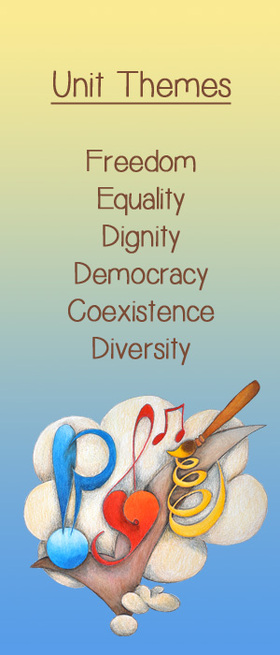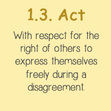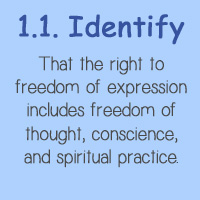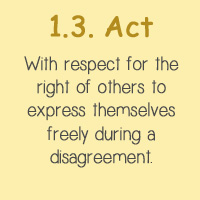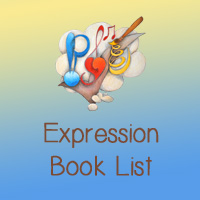Classroom Learning Activities
|
1. Self-Regulation and the Right to Expression
Self-regulation is a biological phenomenon, and it relates to how hard a child has to work in order to deal with the stresses in his or her life. The harder the child works, the less resources they have to learn. Self-control, which is the delay of gratification, is a learned behaviour and involves a number of skills. The better a child can self-regulate, the better they can deal with these stresses, the more they can learn these skills (Stuart Shanker, 2010). Self-regulation enables children to problem solve and think critically. The better a child self-regulates, the more they are going to start to master the skills that lead to self-control and self-discipline. While Dr. Shanker focuses on self-regulation for improved learning, it is also essential in the exercise of the child's right to expression because the child is able to better control his or her responses in social settings. Freedom of expression requires the child be respectful of the right of others to express an opinion, and self-regulation enables the child to regulate their impulses to communicate in a manner that is disrespectful to others. |
For more information on Self-Regulation see:
People for Education Keynote Address: Stuart Shanker |
|
The Zones is a systematic, cognitive behavior approach used to teach self-regulation by categorizing all the different ways we feel and states of alertness we experience into four concrete zones. The Zones curriculum provides strategies to teach students to become more aware of, and independent in, controlling their emotions and impulses, managing their sensory needs, and improving their ability to problem solve conflicts.
By addressing underlying deficits in emotional and sensory regulation, executive functions, and social cognition, the curriculum is designed to help move students towards independent regulation. The Zones of Regulation incorporates Social Thinking® (www.socialthinking.com) concepts and numerous visuals to help students identify their feelings/level of alertness, understand how their behavior impacts those around them, and learn what tools they can use to regulate to a more expected state. Retrieved from www.zonesofregulation.com |
The Zones of Regulation®, (2011, Social Thinking Publishing)
is a curriculum comprised of lessons and activities designed by Leah Kuypers, M. A. Ed., OTR/L to help students gain skills in the area of self-regulation. The lessons and learning activities are designed to help the students recognize when they are in the different Zones (states of alertness/moods) as well as learn how to use strategies (including sensory supports, calming techniques, and thinking strategies) to regulate the Zone they are in. In addition to addressing self-regulation, the students will be gaining an increased vocabulary of emotional terms, skills in reading facial expressions, perspective on how others see and react to their behaviour, insight on events that trigger their behaviour, calming and alerting strategies, problem solving skills and much more. |
The Red Zone is used to describe extremely heightened states of alertness and intense emotions. A person may be elated or experiencing anger, rage, explosive behavior, devastation, or terror when in the Red Zone. A person is described as “out of control” if in the Red Zone.
The Yellow Zone is also used to describe a heightened state of alertness and elevated emotions; however, one has some control when they are in the Yellow Zone. A person may be experiencing stress, frustration, anxiety, excitement, silliness, the wiggles, or nervousness when in the Yellow Zone. The Green Zone is used to describe a calm state of alertness. A person may be described as happy, focused, content, or ready to learn when in the Green Zone. This is the Zone students predominately need to be in the classroom. The Blue Zone is used to describe low states of alertness, such as when one feels sad, tired, sick, or bored. |
Relevant Convention Articles
Article 12
1. States Parties shall assure to the child who is capable of forming his or her own views the right to express those views freely in all matters affecting the child, the views of the child being given due weight in accordance with the age and maturity of the child.
2. For this purpose, the child shall in particular be provided the opportunity to be heard in any judicial and administrative proceedings affecting the child, either directly, or through a representative or an appropriate body, in a manner consistent with the procedural rules of national law.
Article 13
1. The child shall have the right to freedom of expression; this right shall include freedom to seek, receive and impart information and ideas of all kinds, regardless of frontiers, either orally, in writing or in print, in the form of art, or through any other media of the child's choice.
2. The exercise of this right may be subject to certain restrictions, but these shall only be such as are provided by law and are necessary:
(a) For respect of the rights or reputations of others; or
(b) For the protection of national security or of public order (ordre public), or of public health or morals.
Article 14
1. States Parties shall respect the right of the child to freedom of thought, conscience and religion.
2. States Parties shall respect the rights and duties of the parents and, when applicable, legal guardians, to provide direction to the child in the exercise of his or her right in a manner consistent with the evolving capacities of the child.
3. Freedom to manifest one's religion or beliefs may be subject only to such limitations as are prescribed by law and are necessary to protect public safety, order, health or morals, or the fundamental rights and freedoms of others.
Article 15
1. States Parties recognize the rights of the child to freedom of association and to freedom of peaceful assembly.
2. No restrictions may be placed on the exercise of these rights other than those imposed in conformity with the law and which are necessary in a democratic society in the interests of national security or public safety, public order (ordre public), the protection of public health or morals or the protection of the rights and freedoms of others.
Article 17
States Parties recognize the important function performed by the mass media and shall ensure that the child has access to information and material from a diversity of national and international sources, especially those aimed at the promotion of his or her social, spiritual and moral well-being and physical and mental health.
To this end, States Parties shall:
(a) Encourage the mass media to disseminate information and material of social and cultural benefit to the child and in accordance with the spirit of article 29;
(b) Encourage international co-operation in the production, exchange and dissemination of such information and material from a diversity of cultural, national and international sources;
(c) Encourage the production and dissemination of children's books;
(d) Encourage the mass media to have particular regard to the linguistic needs of the child who belongs to a minority group or who is indigenous;
(e) Encourage the development of appropriate guidelines for the protection of the child from information and material injurious to his or her well-being, bearing in mind the provisions of articles 13 and 18.
1. States Parties shall assure to the child who is capable of forming his or her own views the right to express those views freely in all matters affecting the child, the views of the child being given due weight in accordance with the age and maturity of the child.
2. For this purpose, the child shall in particular be provided the opportunity to be heard in any judicial and administrative proceedings affecting the child, either directly, or through a representative or an appropriate body, in a manner consistent with the procedural rules of national law.
Article 13
1. The child shall have the right to freedom of expression; this right shall include freedom to seek, receive and impart information and ideas of all kinds, regardless of frontiers, either orally, in writing or in print, in the form of art, or through any other media of the child's choice.
2. The exercise of this right may be subject to certain restrictions, but these shall only be such as are provided by law and are necessary:
(a) For respect of the rights or reputations of others; or
(b) For the protection of national security or of public order (ordre public), or of public health or morals.
Article 14
1. States Parties shall respect the right of the child to freedom of thought, conscience and religion.
2. States Parties shall respect the rights and duties of the parents and, when applicable, legal guardians, to provide direction to the child in the exercise of his or her right in a manner consistent with the evolving capacities of the child.
3. Freedom to manifest one's religion or beliefs may be subject only to such limitations as are prescribed by law and are necessary to protect public safety, order, health or morals, or the fundamental rights and freedoms of others.
Article 15
1. States Parties recognize the rights of the child to freedom of association and to freedom of peaceful assembly.
2. No restrictions may be placed on the exercise of these rights other than those imposed in conformity with the law and which are necessary in a democratic society in the interests of national security or public safety, public order (ordre public), the protection of public health or morals or the protection of the rights and freedoms of others.
Article 17
States Parties recognize the important function performed by the mass media and shall ensure that the child has access to information and material from a diversity of national and international sources, especially those aimed at the promotion of his or her social, spiritual and moral well-being and physical and mental health.
To this end, States Parties shall:
(a) Encourage the mass media to disseminate information and material of social and cultural benefit to the child and in accordance with the spirit of article 29;
(b) Encourage international co-operation in the production, exchange and dissemination of such information and material from a diversity of cultural, national and international sources;
(c) Encourage the production and dissemination of children's books;
(d) Encourage the mass media to have particular regard to the linguistic needs of the child who belongs to a minority group or who is indigenous;
(e) Encourage the development of appropriate guidelines for the protection of the child from information and material injurious to his or her well-being, bearing in mind the provisions of articles 13 and 18.
Online Resources and References
- Ayahuasca-Wasi Retreats - Non-Violent Communication: Extracts from Marshall Rosenberg Books. Retrieved from: http://www.ayahuasca-wasi.com/english/articles/NVC.pdf.
- Bucket Fillers - Growing up with a bucket full of happiness. Also, here are book activities.
- Canadian International Development Agency (CIDA) Child Protection Unit - Evolving Capacities and Participation by Gerison Lansdown. Also by Gerison Lansdown - Evolving Capacities and the Exercise of Rights (April, 2013).
- Child Rights International Network - Children's Rights and Freedom of Expression.
- Clay, Bob. (2006). Nonviolent Communication. Loch Arthur Community, Scotland.
- Higgins, Jennifer Johnson. (N.D.). School of Education at Johns Hopkins University-Multicultural Children's Literature: Creating and Applying an Evaluation Tool in Re
- Katherine Covell, PhD - Listening to our children (2010): In our hurried world, it is common for much of the communication between parents and their children to consist of the ‘didjas.’ Didja do your homework? Didja brush your teeth? Didja put the cat out? But children have a right to much more than the didjas. The United Nations Convention on the Rights of the Child says that children have a right to have their voices heard, and to have their thoughts solicited and taken into account on matters that affect them. Children have a right to be listened to in their homes, schools, and communities. Read more...
- Humanium - Help the Children: Right to Freedom.
- Kid's Talk - Freedom of Expression and the UN Convention on the Rights of the Child.
- Rosenberg, Marshall B. Raising Children Compassionately. Retrieved from: https://www.cnvc.org/Raising-Children-Compassionately.
- UNICEF - The Convention on the Rights of the Child: Participation Rights - Having an active voice.
- UNICEF - Innocenti Insight: The Evolving Capacities of the Child.
- United Nations - Convention on the Rights of the Child: General Comment No. 12 (2009) - The right of the child to be heard.
- Zones of Regulation - A Concept to Foster Self-Regulation and Emotional Control

